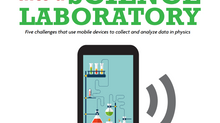5 Ways to Teach Force and Motion
With users from all over the world, Vieyra Software gets lots of requests to make modifications to our Physics Toolbox apps. This morning, we got a request from a teacher in Colombia to provide more supports for lesson ideas and resources. One of the best resources we have found in terms of thinking about how to integrate smartphones into the laboratory have come from our colleagues: namely, from Martin Monteiro and Arturo Marti in Uruguay, and from Philippe Jeanjacquot in France. (Of course, there are others as well! Check out our Twitter list.
Besides our casual collection of lessons on our website, we recently published an article with some lesson ideas. If you are a member of the National Science Teachers Association and receive The Science Teacher magazine, you might have read "Turn Your Smartphone into a Science Laboratory" over this Thanksgiving weekend. Between us (Rebecca and Chrystian Vieyra) and our colleagues in Uruguay and France, we wrote about five different activities using perhaps the most popular sensor: the accelerometer.
The accelerometer provides for a myriad of opportunities to lead students toward the U.S.'s Next Generation Science Standard performance expectation HS-PS2-1: "Analyze data to support the claim that Newton’s second law of motion describes the mathematical relationship amongthe net force on a macroscopic object, its mass, and its acceleration." While we recognize that it takes a LOT of foundational work to help students to develop an understanding about acceleration, here are five ways that mobile devices' accelerometers can help them along the way:
Activity #1: Measure acceleration due to gravity by allowing a mobile device to safely drop onto a bed, sofa, or large pillow. (Make sure your app is set to measure linear acceleration and that it is calibrated to "0" acceleration in all dimensions when at rest).
Activity #2: Measure the net force and motion in an elevator by placing the device flat on the floor of the elevator as it goes up or down a level. Use the mass of the device to estimate the acceleration at various points in the elevator. Draw in quantitative force diagrams.
Activity #3: Measure the linear acceleration directly from an Atwood's machine (modified or standard) after predicting its value theoretically.
Activity #4: Measure the centripetal acceleration while doing a smooth pirouette.
Activity #5: Determine the location of the accelerometer on a record player. Want to know more about how to accomplish this? Check out the introductory video to the article below, with a detailed visual explanation by Philippe Jeanjacquot.
Would you like to see Vieyra Software create a set of coherent, detailed lesson plans for physics education? If so, what would you want to see in them? Feel free to comment below!













